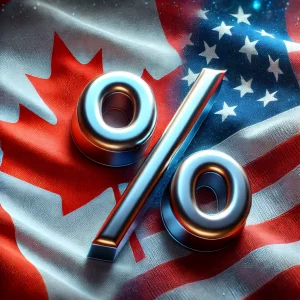A strong U.S. dollar (USD) doesn’t just impact international trade; it also plays a pivotal role in Canada’s financial markets, mortgage rates, and real estate trends. With the U.S. Federal Reserve continuing its efforts to stabilize inflation through interest rate hikes, the USD has maintained its strength, influencing the Canadian dollar (CAD) and indirectly affecting Canadians’ borrowing and housing decisions. This week, we’ll explore the effects of a strong USD on Canadian mortgages and real estate.
1. The Connection Between the U.S. Dollar and Canadian Mortgages
The USD’s strength often drives global investment into U.S. assets, increasing demand for the currency. For Canada, this dynamic impacts both the exchange rate and the economy, influencing Canadian mortgage rates in the following ways:
- Weaker CAD vs. USD: When the U.S. dollar strengthens, the Canadian dollar typically weakens. A lower CAD can make imports more expensive, driving up inflation, which the Bank of Canada may counter by raising interest rates.
- Fixed Mortgage Rates and Bond Yields: Canadian fixed mortgage rates are tied to government bond yields, which are influenced by global market trends. When USD-denominated assets offer higher returns due to Fed rate hikes, demand for Canadian bonds may decrease, leading to higher yields and, consequently, higher fixed mortgage rates.
2. Impact on Real Estate Affordability
A strong U.S. dollar can also influence Canadian real estate affordability, especially for buyers near the border or in urban centers with international investor interest.
- Cross-Border Buyers: For Canadians looking to invest in U.S. real estate, a strong USD increases the cost of purchasing property, potentially discouraging cross-border investments.
- Inflationary Pressure on Housing Costs: A weaker CAD, driven by a strong USD, can increase the cost of building materials and goods imported from the U.S. This adds upward pressure to home prices and renovation costs in Canada.
- Foreign Investor Activity: A strong USD may reduce interest from U.S.-based investors in Canadian real estate, as their purchasing power is diminished relative to domestic investments.
3. Strategic Considerations for Canadian Borrowers
For Canadians navigating the mortgage market in the shadow of a strong U.S. dollar, strategic financial planning is key. Here are practical steps to consider:
- Lock in Fixed Rates Early: Fixed mortgage rates are influenced by bond yields, which may rise in response to global market pressures. Locking in a fixed rate can provide stability amid potential increases.
- Monitor Variable Rate Trends: While variable rates depend directly on the Bank of Canada’s overnight rate, global economic trends, including USD strength, can shape BoC policy decisions. Stay informed on potential changes.
- Consider Timing for Cross-Border Investments: If you’re eyeing U.S. property, consider the exchange rate impact. Waiting for a more favorable CAD-to-USD rate may reduce overall costs.
4. Long-Term Implications for Canadian Housing
The strength of the U.S. dollar underscores the interconnectedness of North American markets, with long-term implications for Canadian housing:
- Resilience of Canadian Real Estate: Despite cross-border influences, Canada’s housing market remains relatively resilient due to strong domestic demand and immigration.
- Economic Growth and Rate Trends: As Canada adapts to the economic ripple effects of U.S. Fed policy, borrowers should expect continued alignment in interest rate trends, albeit with Canadian-specific considerations like housing affordability and consumer debt levels.
Conclusion
The strength of the U.S. dollar has far-reaching implications for Canadian borrowers and the housing market, influencing everything from mortgage rates to real estate affordability. By understanding these dynamics and staying informed about cross-border economic trends, Canadian borrowers can make more strategic decisions about their mortgages and investments. Next week, we’ll dive into whether Canada can decouple from U.S. Fed policy and what that means for mortgage borrowers.
